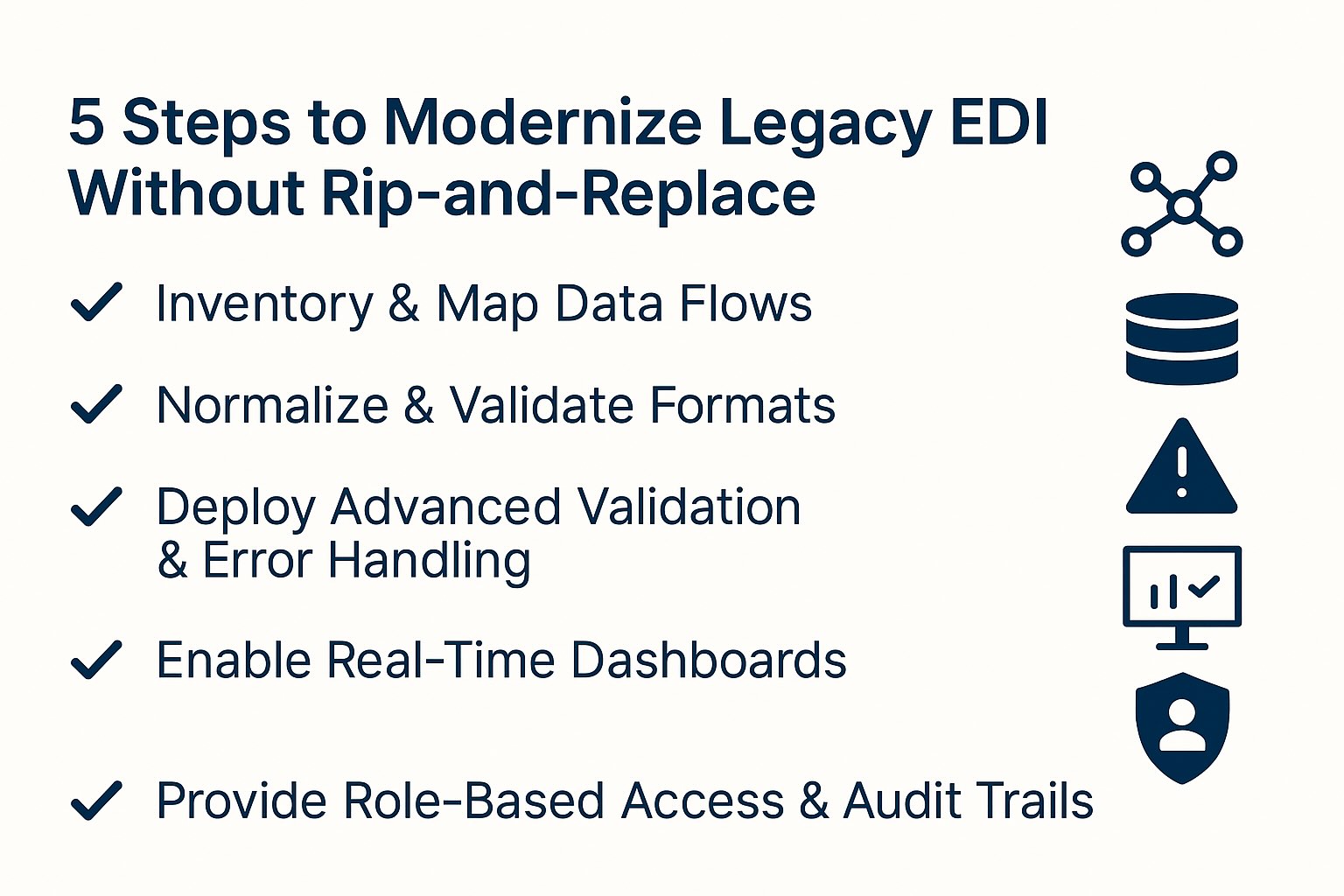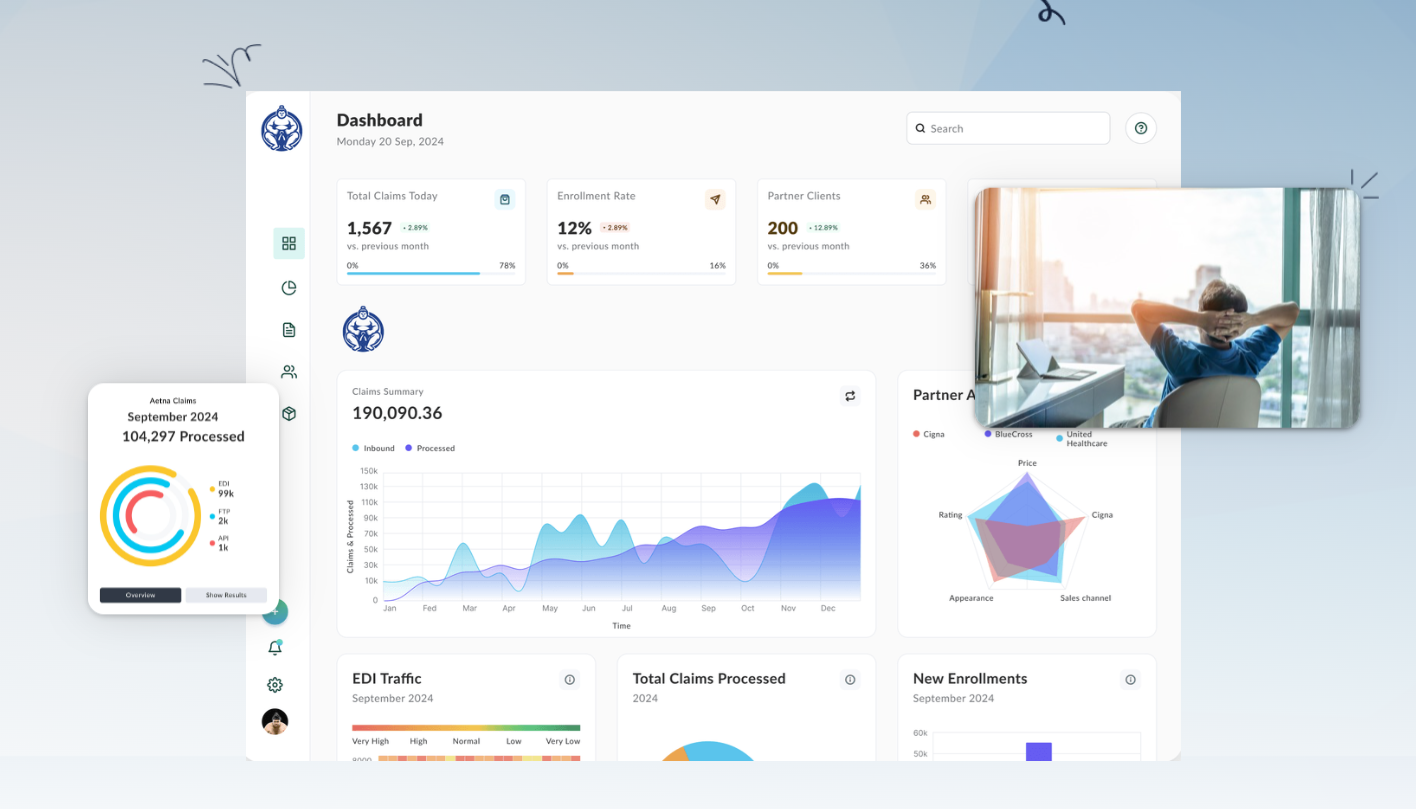How Healthcare Payers Can Seamlessly Integrate Legacy Systems with Modern EDI Solutions


Healthcare payers today stand at a crossroads: ongoing digital transformation demands real-time, clean, actionable data, yet the reality for most organizations is a complex web of legacy enrollment systems, aging claims engines, and a constant barrage of new compliance requirements. The challenge isn't just about technology – it’s about trust, efficiency, and regulatory risk management across a broad and varied technical landscape.

The Legacy Integration Dilemma
Let’s face it: most U.S. healthcare payers are working with platforms built decades ago, whether home-grown, mainframe, or vertical solution. These systems excelled at their peak, but struggle today to accommodate modern demands such as real-time eligibility checks, complex enrollment file formats, and strict HIPAA or GDPR auditability. Integrating these environments with newer, cloud-native EDI solutions—or even just achieving consistent data quality—is no simple task.
Why Modernize Legacy EDI?
- Regulatory Pressure: HIPAA, HITECH, and ongoing state mandates keep raising the bar on privacy, auditability, and electronic record handling.
- Member Expectations: Health plan subscribers now expect self-service access, real-time enrollment status, and fast claims adjudication.
- Data Complexity: Enrollment and claims data pours in from brokers, employer groups, state and federal exchanges, and partners—using everything from standard EDI 834 to custom CSVs, XML files, or proprietary layouts.
- Operational Cost: Siloed help desks and IT staff end up troubleshooting basic issues—costing time, risking SLAs, and draining IT resources.

Our EDI Integration Philosophy: Start with the Data
At EDI Sumo, we believe integration isn’t fundamentally about ‘connecting systems’—it’s about translating, validating, and exposing your data where it’s actually needed. Regardless of whether your legacy system is 15 years old, it contains mission-critical information that powers eligibility, claims, and customer service. The challenge? Getting that data standardized, validated, and made actionable—without replacing your existing investments or breaking compliance.
Key Steps for Seamless Legacy Integration
- Inventory & Map Data Flows Begin by rigorously mapping out all inbound and outbound data sources: EDI X12 834 files, Excel sheets, positional flat files, proprietary XML feeds. Identify all the systems that touch eligibility, enrollment, and claims.
- Normalize & Validate Formats Modern EDI solutions thrive on standardization. At EDI Sumo, we make it possible to bring in any format—EDI, CSV, XML, or custom—and normalize them into a common, clean model. This greatly reduces custom mapping logic and error-prone manual “fixes.”
- Deploy Advanced Validation & Error Handling Most legacy systems can only handle a fixed set of standard errors. Our approach is to bring in enhanced validation and discrepancy alerts before data lands in your core systems, uncovering issues that would otherwise show up as downstream claim rejections or member complaints.
- Enable Real-Time Dashboards & Monitoring One of the biggest pain points with legacy platforms is the lack of real-time visibility. EDI Sumo enables live tracking of file exchanges, eligibility status, and automated alerts—so IT and business users know what’s going on before SLAs are at risk.
- Provide Role-Based Access & Audit Trails Compliance doesn’t stop at the data layer. HIPAA-ready audit logs, user tracking, and granular access controls empower business teams to self-service eligibility and claim status—while keeping your compliance officer happy.
- Integrate Seamlessly with Existing Systems Modernizing should not mean ‘rip and replace’. Our architecture is designed to sit next to your core platforms and safely hand off validated, standardized data—minimizing technical risk and change management headache.
EDI Sumo’s Unique Approach to Legacy/Modern Integration
We’ve partnered with healthcare payers of every size to help them:
- Connect to All Formats: From EDI X12 files to custom Excel templates and flat files—we make them all speak the same language.
- Validate at Every Stage: Real-time error detection, custom validations, and compliance-ready audit trails nip problems in the bud.
- Expose Data to the Business: Give enrollment and support teams self-serve search, history, and analytics, freeing IT from every inquiry.
- Integrate with Your Existing Stack: EDI Sumo is designed for seamless integration with industry claims management systems and EDI translators, minimizing disruption and maximizing up-time.
Benefits of a Seamless Integration Strategy
- Accelerate Claims and Eligibility Processing: Dramatically cut data lag from days to near real-time, keeping members satisfied and compliant with contract SLAs.
- Slash IT Support Burden: Free up specialized staff by empowering the business to solve enrollment and claim list issues directly.
- Minimize Risk and Compliance Exposure: Automated audit logs, strong encryption, and real-time alerts mean you’re always ready for HIPAA and partner audits.
- Lower Overall Cost: Reducing manual touchpoints, error remediation time, and downtime delivers rapid ROI.
Typical Roadblocks—And How We Solve Them
"We can’t replace our core system—what if things break?"
We get it. Most modern EDI solutions (including ours) are deployed alongside existing platforms—acting as a data broker and validator, not a replacement. You retain control and minimize change.
"Our data is all over the place in different formats."
Standardizing and validating data coming from brokers, group plans, and trading partners is core to what we do. Our architecture is built to make all these sources interoperable without custom code for each new file.
"How do we ensure compliance and security in this process?"
With best-in-class encryption, HIPAA/GDPR adherence, multi-factor authentication, and end-to-end audit trails, all processed data is protected both in transit and at rest. Deployed on your infrastructure, you maintain data sovereignty and visibility. See our Trust Center for details.
Step-by-Step: How an Integration Project Might Look
- Initial Discovery – Identify all legacy and modern systems, required data formats, integration points, and compliance constraints.
- Mapping & Validation Design – Set up data transformation and validation rules based on organizational business processes, not just file format specs.
- Pilot & Sandbox Testing – Safely ingest, validate, and process real-world files without disrupting production.
- Phased Go-Live – Roll out in manageable waves (e.g., one trading partner or file type at a time), with constant monitoring and error alerting.
- Continuous Optimization – Review auto-generated reports, root-cause analysis, and SLA dashboard metrics to drive ongoing improvements.
Real, Practical Benefits—With Minimal Disruption
Modern EDI integration shouldn't mean weeks of downtime, risky migrations, or yet another complex tool only IT can operate. Our approach puts elegant, compliant, and automated data management within reach—so your core operations can stay focused on serving members and partners, not endlessly troubleshooting formats and files.

Get Started—See It in Action
If you’re a CIO, IT Director, EDI Coordinator, or anyone involved in payer operations looking to bridge the old and the new, we invite you to see what real, modern EDI data management can do for you—without unnecessary risk and complexity. Learn more or schedule a demo with EDI Sumo to experience how easy seamless legacy integration can be.


.png)





.png)

.png)


.png)
